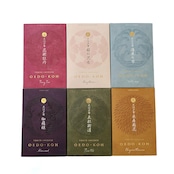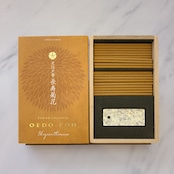・翌月にまとめてお支払い可能
・手数料無料(口座振替の場合)
・アプリでご利用金額を確認できて安心














¥1,815 税込
なら 手数料無料の 翌月払いでOK
【伽羅姫/KYARA-HIME】
公家から大名などの富裕層へも広がりをみせた「香道」。
庶民の間でも香木への想いは強く、歌舞伎や浄瑠璃の演目にあでやかに登場。当時、伽羅という単語は”すてきなもの”を形容する表現に。さらに「伽羅の油」という生薬で香りづけした鬢付油も大ヒット。
江戸の人々にとって憧れの的だった伽羅をイメージした香り。
Incense-smelling ceremonies were the practice of court nobles, feudal lords and other wealthy people.
Among commoners as well, while they may have lacked access to genuine fragrant woods, there was much fascination with them, and they are frequently featured in works of Kabuki and Joruri theater.
The word kyara, meaning aloeswood, even became a general term for “something wonderful.”
Hair wax that evokes the scent of aloeswood was extremely popular as well.
Experience the fragrance, and understand why it was the most highly prized of scents.
【花街牡丹/HANAMACHI-BOTAN】
江戸で人々を魅了し、爆発的な人気を誇った牡丹の花。
その姿は妖艶で美しい芸者たちを連想させ、歌と踊りが聞こえてくるよう。
限られた者だけがお座敷で楽しむことのできる芸の世界。
江戸の町では茶屋での芸の時間を香の煙で計ったこともあったとか。
そんな浮世を離れた美しさを想起させる“百花の王”牡丹の香り。
The enchanting peony enjoyed enormous popularity in Edo. Its bewitching form is reminiscent of a beautiful geisha, and gazing upon a peony you can almost hear the music and see the dances of the geisha quarter.
This was an exclusive world for the privileged few, and it is said that customers’ time spent in teahouses was measured by sticks of incense. The fragrance of the peony, “queen of the flowers” evokes this beautiful and evanescent world.
【桜の花衣/SAKURA NO HANAGOROMO】
江戸時代に本格化する花見文化。今もなおその美しさを受け継ぐ染井吉野は幕末に江戸の郊外 “染井村” から出た園芸種。江戸の人々にとって、花見は出会いの場であり、自分をみせるパフォーマンスの場。「花衣」というおそろいの衣装をまとい、春を喜び歌い踊ることもあったとか。
春を彩り人々を魅了し続ける桜の香り。
The custom of cherry blossom viewing took hold during the Edo Period.
The somei-yoshino cherry tree, seen in groves throughout Japan today, was originally an ornamental garden variety raised in the village of Somei near Edo. Cherry blossom viewings were also an opportunity for Edo denizens to meet one another, present themselves, and perform : matching fancy kimonos were worn for the occasion, and people sang and danced to celebrate the coming of spring.
The captivating scent of cherry blossoms heralds spring’s arrival.
【長寿菊花/CHOUJU-KIKKA】
江戸の菊ブームは江戸近郊の駒込・巣鴨の植木屋が火付け役といわれ、花壇菊、菊細工など、派手好きの江戸っ子は形も香りもよい菊に熱狂。古来より延寿の力があるといわれ、薬草として用いられた菊を浸した菊酒で祝う、重陽の節句(菊の節句)が五節句の一つとなったのもこの時代。
江戸っ子に愛された清涼でなめらかな菊の香り。
The gardeners of Komagome and Sugamo near Edo are said to have sparked the chrysanthemum craze of the Edo era.
Fond of the fancy and spectacular, Edo dwellers loved the beautiful and fragrant flowers, which were displayed or fashioned into various shapes. Chrysanthemums were believed since ancient times to prolong life, and during the Edo Period the Chrysanthemum Festival became a yearly event where people drank chrysanthemum sake infused with medicinal blossoms. The smooth, refreshing scent of chrysanthemum will delight you as it did the denizens of old Edo.
【玉松街道/TAMAMATSU-KAIDO】
神は常緑樹に宿るといわれ、木に降りてくるのを「待つ」という意味にもひっかけて、松竹梅、鶴と松、門松、能舞台など、松は長寿や縁起物の象徴に。
浮世絵にも、江戸時代の人々の往来の中に、堂々と描かれた松は当時の象徴的な風景の一つ。
旅の無事を祈りつつ、街道を行き来する人々を見守り続けた清々しい松の香り。
It is traditionally believed that the kami (deities) dwell in evergreen trees. The word matsu means both “pine” and “to wait” (for the deity to descend), and the pine is part of the felicitous trio of pine, bamboo and plum tree, and the auspicious pairing of crane and pine. Pine decorations are displayed at New Year’s, and a monumental pine tree is painted on the backdrop of the Noh stage – all expressing the pine’s association with luck and longevity. In ukiyo-e woodcuts, boldly rendered pines standing in the midst of Edo-era people bustling to and fro are a classic motif. Savor the refreshing scent of pine, the tree that guards the travelers’ road and watches over their safe return.
【湯屋の雫/YUYA NO SHIZUKU】
江戸時代はまだ家に風呂がなく、湯屋が次々に作られ、その数約600軒。
初期の蒸し風呂のようなものから次第に湯船の形式へ。湯屋では身分を越え、老若男女問わず文字通り裸の付き合い。湯上がりには、蘭引(らんびき)とよばれる蒸留器で花を蒸留した化粧水なども人気だったとか。
あたたかくふわりと香る華やかな湯上がりの香り。
In the Edo Period (1603-1868) people didn’t have baths at home, and public bathhouses were built to meet the need. There were about 600 in Edo. At first they were steam baths, then large bathtubs were developed. As all were naked and people comingled without regard for age, gender, or rank, the bathhouse was an egalitarian place. Apparently another popular item was a scented lotion made with floral essences distilled using a still known as a ranbiki.
This fragrance has the warmth and friendly glow of the moment you step out of the bath.
お香サイズ:約5.5㎝
商品サイズ:高さ約10㎝×幅約6.5㎝×奥行約2㎝
重量:約42g
商品内容:お香スティック60本、香立て(錫製)
主原料:タブ粉、香料
レビュー
(121)
送料・配送方法について
お支払い方法について